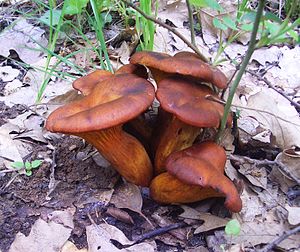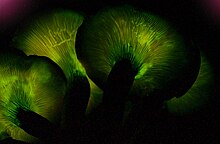Dark olive funnel
| Dark olive funnel | ||||||||||||
|---|---|---|---|---|---|---|---|---|---|---|---|---|

Dark olive funnel ( Omphalotus olearius ) |
||||||||||||
| Systematics | ||||||||||||
|
||||||||||||
| Scientific name | ||||||||||||
| Omphalotus olearius | ||||||||||||
| ( DC .: Fr. ) Singer |
The Dark Olive Deceiver ( Omphalotus olearius ) or Dark olive tree fungus is a stand mushrooms from the family of Omphalotaceae. The scientific name means "umabelter Ohrling" (= Omphalotus ) on " olive tree growing" (= olearius ). The dark olive mushroom is a very effective poisonous mushroom. Its mycelium and its lamellae show the phenomenon of bioluminescence : They glow in the dark.
features

The relatively thin-fleshed hat is bright orange to brown-orange or brownish-red in color and only rarely yellowish and discolored green with potassium hydroxide (KOH). It reaches a diameter of five to eight centimeters. The hat is initially arched, then spread out flat and finally depressed or deepened in a funnel shape, a central hat hump is missing. The edge is often curled and the hat skin is smooth. The narrow lamellas that run down the handle are bright orange-yellow in color. They glow recognizably in the dark when the eyes have switched to dark vision. This glow - called Foxfire - is triggered by the enzyme luciferase and is a form of bioluminescence . The principle of operation is similar to that of the firefly . The tough stem is colored like the hat, five to twenty centimeters long and two to five centimeters thick, is often a bit eccentric, sometimes tapers towards the base of the stem and its surface is longitudinally fibrous. The poisonous flesh is yellowish to orange in color and is tough and fibrous. It smells intensely aromatic, not precisely definable (at least without a sweet component) and tastes astringent. The spore print is tinted yellow. The colorless, hyaline, inamyloid spores under the microscope measure 5.8–7.0 (–9.5) x (4.6–) 5.3–7 (–8.0) µm.
Species delimitation
Omphalotus illudens is very similar , the second species of olive tree mushroom found in Europe, which was described from North America but is native to both continents. Macroscopically, both are extremely similar. Omphalotus illudens is yellow to yellow-orange in color and does not show any brown tones, but the colors of both species overlap, so that they cannot always be differentiated by the color, and the dark olive mushroom can also be pure yellow. One possibility of differentiation, however, is the expression of a small hump or papilla in the middle of the hat of Omphalotus illudens, a feature that does not occur in the dark olive mushroom ( Omphalotus olearius ). Anatomically, the two types can be distinguished by the frequency of refractive hyphae in the top layer of the hat . These occur frequently in Omphalotus illudens , while they are rare or absent in Omphalotus olearius . In addition, the spores of Omphalotus illudens are smaller than those of Omphalotus olearius . This is clearly shown in the spore volume, which in Omphalotus olearius is almost twice as large as in Omphalotus illudens . Genetically, both types can be very well z. B. with the help of the barcoding region ITS of the rDNA .
Omphalotus subilludens only occurs in North America and therefore cannot be confused with the dark olive tree mushroom in Europe.
Wherever it occurs together with the chanterelle in the same habitat, it can easily be confused with it by laypeople. While the chanterelle is pale yellow to yolk yellow, the olive tree funnel is more orange-yellow to orange-red. However, the olive mushroom always grows on wood, the chanterelle always on the ground; likewise the similar Fuchsige red chalk knight .
Ecology and phenology
The dark olive tree funnel lives parasitically or saprobionic on deciduous trees. It usually grows in tufts on olive trees , sometimes also on oaks or sweet chestnuts . The mushroom appears from July to October.
distribution
The heat-loving dark olive tree funnel is widespread and quite common in the Mediterranean area , very rare in Central Europe, but also occurs in Great Britain. It is more common to the south than its doppelganger, Omphalotus illuden s, which is also found north of the Alps e.g. B. in Germany (Baden-Württemberg, Saarland, Rhineland Palatinate, Hesse and Saxony) occurs.
Systematics
The relationship of the genus of the olive tree mushrooms ( Omphalotus ) and thus also of the dark olive tree mushroom was assumed for a long time following the habit of the knightly relatives (Tricholomataceae) within the mushroom-like (Agaricales). Later, it was assumed that it is representative of the Dickröhrlingsartigen (Boletales) and here the brim Ling relatives is (Paxillaceae), because in the dark olive mushroom ( Omphalotus olearius ) and Omphalotus illudens next Telephorsäure typical for boletales pigments such Atromentin , Atromentinsäure , Xerocomsäure , Variegate acid or gyroporin were detected. Atromentin is one of the main pigments of the velvet- toe curling , which was also counted among the curling relatives in the past, but is now seen as part of the wood curling relatives (Tapinellaceae, Tapinellinaeae) within the thick tubule -like family .
More recent genetic studies, on the other hand, show that the dark olive mushroom belongs to the order of the mushroom-like (Agaricales), despite the pigments typical of large boletus-like species, but not to the family of knightly relatives, but together with turnip to dizzying mushroom genera such. B. the pink sprouts ( Rhodocollybia ), pale sprouts ( Gymnopus ) or dwarf dwarves ( Marasmiellus ) in the own family of the Omphalotaceae.
Within the genus Omphalotus , the closest related species are Omphalotus japonicus , O. olivascens and the Australian ghost mushroom ( Omphalotus nidiformis ). Together with Omphalotus subilludens , a species that is related somewhat further apart, they form the Omphalotus olearius clade.
Omphalotus illudens , although very similar, is not closely related to the dark olive mushroom and forms a separate clade with Omphalotus mexicanus . This shows that the North American and European collections of Omphalotus illudens are genetically indistinguishable in relation to the areas of DNA examined so far. The differentiation of Omphalotus illudens from the dark olive tree mushroom at the species level is genetically completely unequivocal.
ingredients
However, from the starting substance Δ-6 proto-illudes, it forms many other sesquiterpenes such as B. the Illudins A, B, C, D, E, M, S, the Dihydro-Illudin M, the 4α-Hydrocyhydro-Illudin, the Illudacetal acid, the Illudaneol, the Illudal acid, the Illudosin, the Illudiolon, the Illudoson -Halfacetal, the Illudol, the Neoilludol, the Isoomphadiolon, the Illudinin or the Omphadiol. In the sister species Omphalotus illudens , sesquiterpenes such as the illudoson hemiacetal, the illudiolon, the isoomphadion or the omphadiol have also been detected. The toxicity of the dark olive tree fungus is due to sesquiterpenes such as Illudin S and other toxins such as B. back the lunamycin or lampterol, which it also contains. The lunamycin is said to have anti-tumor effects. Illudins such as Illudin S or Illudin M also show tumor-inhibiting effects.
The Dark olive mushroom contains, inter alia, the pigments Atromentin , Atromentinsäure, Thelephorsäure , Xerocomsäure, Variegatsäure and Gyroporin.
Toxicity
The dark olive tree funnel is very poisonous, if not fatally poisonous. One to three hours after the mushroom meal, bitter taste in the mouth, headache, sweating, nausea, vomiting, and abdominal cramps have been reported, while diarrhea is less common. According to reports, recovery from symptoms sometimes occurs relatively quickly (after four hours), and sometimes the poisoning lasts up to five days. The illudins M and S as well as lampterol and lunamycin are suspected to be the triggering toxins, although other effective toxins cannot be excluded.
swell
- Ettore Bielli: mushrooms. A comprehensive guide to identifying and collecting mushrooms. Neuer Kaiser-Verlag, Klagenfurt 1998, ISBN 3-7043-2179-6 , p. 129 (Original edition: Funghi. Conoscere, riconoscere e ricercare tutte le specie di funghi piu diffuse. Istituto Geografico De Agostini, Novara 1997, ISBN 88-415 -4140-7 ).
- Kai Welzel: Molecular biological studies on non-ribosomal peptide synthesis in Omphalotus olearius. WiKu-Verlag Verlag for Science and Culture, Berlin 2005 (recte 2006), ISBN 3-86553-138-5 (also: Kaiserslautern, Technical University, dissertation, 2005).
Web links
- On the luminosity of the fungus (English)
Individual evidence
- ^ A b Juan Lois Mata, Karen W. Hughes, Ronald H. Petersen: An investigation of / omphalotaceae (Fungi: Euagarics) with emphasis on the genus Gymnopus . In: Sydowia . tape 20 , 2007, p. 191-289 .
- ↑ a b Jadson JS Oliveira, Ruby Vargas-Isla, Tiara S. Cabral, Doriane P. Rodrigues, Noemia K. Ishikawa: Progress on the phylogeny of the Omphalotaceae: Gymnopus s. str., Marasmiellus s. str., Paragymnopus gen. nov. and Pusillomyces gen. nov. In: Mycological Progress . tape 18 , no. 5 , May 2019, ISSN 1617-416X , p. 713-739 , doi : 10.1007 / s11557-019-01483-5 .
- ↑ a b Omphalotaceae. Retrieved April 28, 2020 .
- ↑ a b c d e f g h i Fabrizio Boccardo, Mido Traverso, Alfredo Vizzini, Mirca Zotti: Fungi d'Italia . 1st edition. Zanichelli, Bologna 2008, p. 1-623 .
- ↑ a b c d e f g h i j M. Kirchmair, R. Pöder: Why Omphalotus illudens (Schwein.) Bresinsky et Besl is an independent species. In: Revista Catalana de Micologia . tape 24 , 2002, pp. 2 15-223 .
- ↑ a b Martin Kirchmair, Sandra Morandell, Daniela Stolz, Reinhold Pöder, Christian Sturmbauer: Phylogeny of the genus Omphalotus based on nuclear ribosomal DNA sequences . In: Mycologia . tape 96 , no. 6 , November 2004, ISSN 0027-5514 , p. 1253-1260 , doi : 10.1080 / 15572536.2005.11832875 .
- ↑ dissemination Omphalotus illudens (Schwein.) Bresinsky & Besl 1979. In: fungi of Germany. German Society for Mycology, accessed on May 4, 2020 .
- ^ Rolf Singer: The Agaricales in modern Taxonomy . 3. Edition. Cramer, Vaduz 1975, p. 1-912 .
- ↑ a b c Andreas Bresinsky, Helmut Besl: To the family connection of Omphalotus . In: Supplements to Sydowia . tape 8 , 1979, pp. 98-109 .
- ^ A b Rolf Singer: The Agaricales in modern Taxonomy . 4th edition. Koeltz Scientific Books, Koenigstein 1986, p. 1-981 .
- ↑ Manfred Binder, David S. Hibbett: Molecular systematics and biological diversification of Boletales . In: Mycologia . tape 98 , no. 6 , November 2006, ISSN 0027-5514 , p. 971-981 , doi : 10.1080 / 15572536.2006.11832626 .
- ↑ a b Grayson T. Wawrzyn, Maureen B. Quin, Swati Choudhary, Fernando López-Gallego, Claudia Schmidt-Dannert: Draft Genome of Omphalotus olearius Provides a Predictive Framework for Sesquiterpenoid Natural Product Biosynthesis in Basidiomycota . In: Chemistry & Biology . tape 19 , no. 6 , June 2012, p. 772-783 , doi : 10.1016 / j.chembiol.2012.05.012 ( elsevier.com ).
- ↑ a b c Trevor C McMorris, A Kashinatham, Ricardo Lira, Henrik Rundgren, Peter K Gantzel: Sesquiterpenes from Omphalotus illudens . In: Phytochemistry . tape 61 , no. 4 , October 2002, p. 395-398 , doi : 10.1016 / S0031-9422 (02) 00205-4 .
- ↑ Trevor C. McMorris, Ricardo Lira, Peter K. Gantzel, Michael J. Kelner, Robin Dawe: Sesquiterpenes from the Basidiomycete Omphalotus illudens . In: Journal of Natural Products . tape 63 , no. November 11 , 2000, ISSN 0163-3864 , p. 1557-1559 , doi : 10.1021 / np9904760 .
- ↑ a b c d Th. Zilker, JJ Kleber, B. Haberl: Ölbaumpilz (Omphalotus olearius). In: www.toxinfo.org. Toxicological Department, Klinikum Rechts der Isar, Munich, 2000, accessed on May 4, 2020 .
- ↑ Haruhisa Shirahama, Yohei Fukuoka, Takeshi Matsumoto: Isolation and Characterization of Lunamycin, an Antitumoric Substance from Lampteromyces japonicus . In: Bulletin of the Chemical Society of Japan . tape 35 , no. 6 , June 1962, ISSN 0009-2673 , pp. 1047-1048 , doi : 10.1246 / bcsj.35.1047 ( csj.jp [PDF]).